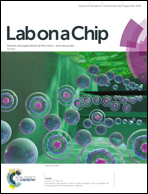Selective intracellular delivery and intracellular recordings combined in MEA biosensors†
Abstract
Biological studies on in vitro cell cultures are of fundamental importance to investigate cell response to external stimuli, such as new drugs for the treatment of specific pathologies, or to study communication between electrogenic cells. Although three-dimensional (3D) nanostructures brought tremendous improvements on biosensors used for various biological in vitro studies, including drug delivery and electrical recording, there is still a lack of multifunctional capabilities that could help gain deeper insights in several bio-related research fields. In this work, the electrical recording of large cell ensembles and the intracellular delivery of few selected cells are combined on the same device by integrating microfluidic channels on the bottom of a multi-electrode array decorated with 3D hollow nanostructures. The novel platform allows the recording of intracellular-like action potentials from large ensembles of cardiomyocytes derived from human induced pluripotent stem cells (hiPSC) and from the HL-1 line, while different molecules are selectively delivered into single/few targeted cells. The proposed approach shows high potential for enabling new comprehensive studies that can relate drug effects to network level cell communication processes.



 Please wait while we load your content...
Please wait while we load your content...